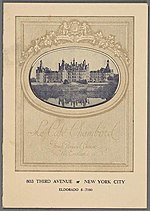550 Madison Avenue

550 Madison Avenue (formerly known as the Sony Tower, Sony Plaza, and AT&T Building) is a postmodern skyscraper at Madison Avenue between 55th and 56th Streets in the Midtown Manhattan neighborhood of New York City. Designed by Philip Johnson and John Burgee with associate architect Simmons Architects, the building was completed in 1984 as the headquarters of AT&T and later became the American headquarters of Sony. The building consists of a 647-foot-tall (197-meter), 37-story office tower with a facade made of pink granite. It originally had a four-story granite annex to the west, which was demolished and replaced with a shorter annex in 2020. At the base of the building is a large entrance arch facing east toward Madison Avenue, flanked by arcades with smaller flat arches. A pedestrian atrium, connecting 55th and 56th Streets midblock, was also included in the design, which enabled the building to rise higher without the use of setbacks. The ground-level lobby is surrounded by retail shops, which were originally an open arcade. The office stories are accessed from a sky lobby above the base. Atop the building is a broken pediment with a circular opening. The building has received much attention ever since its design was first announced in March 1978. The AT&T Building at 550 Madison Avenue was intended to replace 195 Broadway, the company's previous headquarters in Lower Manhattan. Following the breakup of the Bell System in 1982, near the building's completion, AT&T spun off its subsidiary companies. As a result, AT&T never occupied the entire building as it had originally intended. Sony leased the building in 1991, substantially renovated the base and interior, and acquired the structure from AT&T in 2002. Sony sold the building to the Chetrit Group in 2013 and leased back its offices there for three years. In 2016, the Olayan Group and Chelsfield purchased 550 Madison Avenue with plans to renovate it. 550 Madison Avenue was designated a city landmark by the New York City Landmarks Preservation Commission in 2018.
Excerpt from the Wikipedia article 550 Madison Avenue (License: CC BY-SA 3.0, Authors, Images).550 Madison Avenue
Madison Avenue, New York Manhattan
Geographical coordinates (GPS) Address External links Nearby Places Show on map
Geographical coordinates (GPS)
| Latitude | Longitude |
|---|---|
| N 40.761388888889 ° | E -73.973333333333 ° |
Address
550 Madison Avenue (Sony Tower;Sony Building;SonyPlaza;AT&T Building)
Madison Avenue 550
10037 New York, Manhattan
New York, United States
Open on Google Maps




